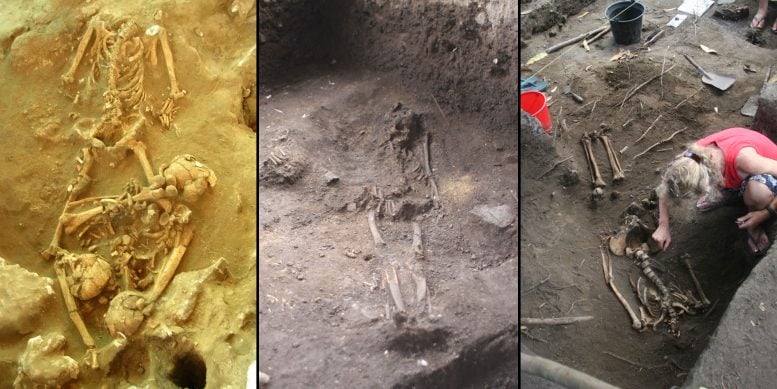
Ancient skeleton at the Teouma site on Efate and burial excavations on Uripiv Island Malakula. Credit; ANU
Researchers from The Australian National University (ANU) have helped put together the most comprehensive study ever conducted into the origins of people in Vanuatu – regarded as a geographic gateway from Asia to the Remote Pacific.
The new research, published across two separate research papers, uses a combination of DNA analyses of ancient skeletons and modern samples, as well as archaeological evidence, to put together a complete timeline of migration to the island nation.
The results confirm that Vanuatu’s first people were of the Lapita culture and arrived 3,000 years ago from South East Asia, followed by Papuan arrivals from the island of New Britain, in the Bismarck Archipelago just to the east of New Guinea and part of the nation of Papua New Guinea.
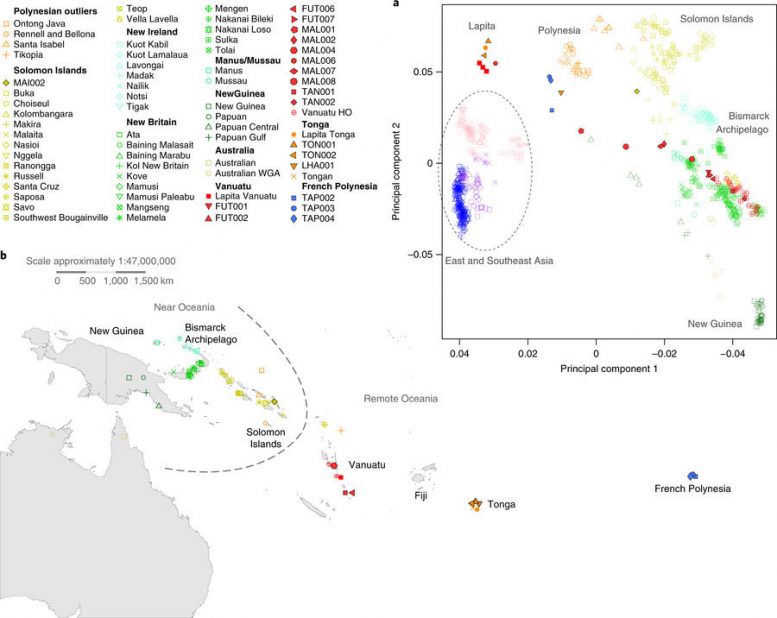
a, PCA of modern-day East Asian and Near and Remote Oceanian populations genotyped on the Axiom Genome-Wide Human Origins Array, with 23 ancient individuals projected. Ancient samples are indicated by filled symbols and present-day samples are indicated by open symbols (WGA, whole genome assembly). The new data from this study have a black border. b, Regional map showing the locations of Near and Remote Oceanian sample populations and ancient individuals. Cosimo Posth, et al., Nature Ecology & Evolution (2018) doi:10.1038/s41559-018-0498-2
Dr. Stuart Bedford of the ANU School of Culture History and Language said this was the first time researchers had been able to look at a full sequence of DNA samples from the Vanuatu islands.
“We’ve been able to track a complete genetic timeline at regular intervals starting with the first inhabitants right through to modern times,” Dr. Bedford said.
“The very first generation of people into Vanuatu are primarily Asian, then very quickly you see a series of migrations of Papuan people from the Bismarck Archipelago who had been living in the region for around 50,000 years.
“That trend continues over the next 3,000 years right up until today as the genetic ancestry was mostly replaced by that of Papuan migrants. The people of Vanuatu today, like many peoples of the Pacific, can claim a dual heritage.”
Co Researcher Professor Matthew Spriggs of the ANU School of Archaeology and Anthropology said for the first time researchers could determine exactly where these Papuan migration groups came from.
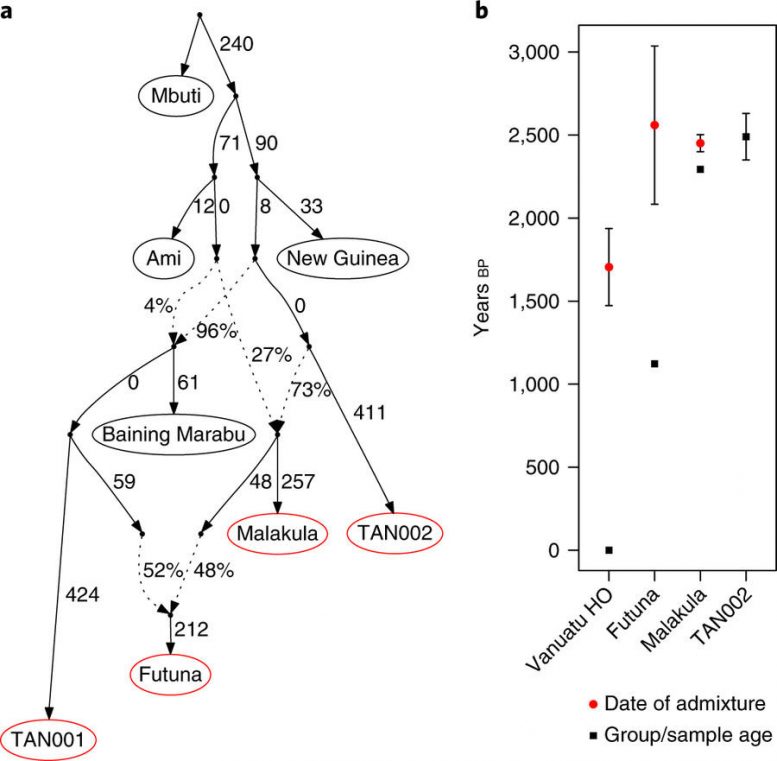
a, qpGraph model that fits the observed allele frequency patterns with branch lengths representing drift in FST × 1,000 units and edge percentages indicating admixture proportions. Ancient samples or groups are indicated with a red border. b, ALDER analyses estimating the date of Papuan and East Asian admixture, converted into years with a generation time of 28.1 yr. Bars show s.e. for date estimates. The sample ages for the two ancient groups (Futuna and Malakula) are averaged radiocarbon dating confidence interval midpoints. As the earliest ancient Vanuatu individual with unadmixed Near Oceanian ancestry, TAN002 is included for age comparison, with the error bar indicating the 95.4% radiocarbon dating confidence interval. Cosimo Posth, et al., Nature Ecology & Evolution (2018) doi:10.1038/s41559-018-0498-2
“They came from New Britain, a Papuan island just east of New Guinea,” Professor Spriggs said.
“This makes sense. New Britain has some of the earliest known Lapita sites.
“So what we think happened is that Lapita people after arriving in New Britain moved fairly directly on to Vanuatu and encouraged some of the local populations already in place on New Britain to move there as well.”
Dr. Bedford said the strength of the Lapita culture was evident in the continuity of the language.
“The Lapita people who originally came to Vanuatu from South East Asia spoke a form of Austronesian,” Dr. Bedford said.
“That language persisted and over 120 descendant languages continue to be spoken today, making Vanuatu the most linguistically diverse place on Earth per capita.
“This is a unique case, where a population’s genetic ancestry was replaced but its languages continued.”
The two papers were published in the Nature Ecology & Evolution and Current Biology journals respectively.
The study team was made up of researchers from around the world including at the ANU, the Vanuatu National Museum, Harvard Medical School, and the Max Planck Institute for the Science of Human History.
References:
- “Language continuity despite population replacement in Remote Oceania” by Cosimo Posth, Kathrin Nägele, Heidi Colleran, Frédérique Valentin, Stuart Bedford, Kaitip W. Kami, Richard Shing, Hallie Buckley, Rebecca Kinaston, Mary Walworth, Geoffrey R. Clark, Christian Reepmeyer, James Flexner, Tamara Maric, Johannes Moser, Julia Gresky, Lawrence Kiko, Kathryn J. Robson, Kathryn Auckland, Stephen J. Oppenheimer, Adrian V. S. Hill, Alexander J. Mentzer, Jana Zech, Fiona Petchey, Patrick Roberts, Choongwon Jeong, Russell D. Gray, Johannes Krause and Adam Powell, 27 February 2018, Nature Ecology & Evolution.
DOI: 10.1038/s41559-018-0498-2 - “Population Turnover in Remote Oceania Shortly after Initial Settlement” by Mark Lipson, Pontus Skoglund, Matthew Spriggs, Frederique Valentin, Stuart Bedford, Richard Shing, Hallie Buckley, Iarawai Phillip, Graeme K. Ward, Swapan Mallick, Nadin Rohland, Nasreen Broomandkhoshbacht, Olivia Cheronet, Matthew Ferry, Thomas K. Harper, Megan Michel, Jonas Oppenheimer, Kendra Sirak, Kristin Stewardson, Kathryn Auckland, Adrian V.S. Hill, Kathryn Maitland, Stephen J. Oppenheimer, Tom Parks, Kathryn Robson, Thomas N. Williams, Douglas J. Kennett, Alexander J. Mentzer, Ron Pinhasi and David Reich, 28 February 2018, Current Biology.
DOI: 10.1016/j.cub.2018.02.051

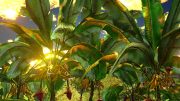
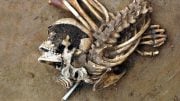
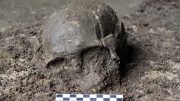
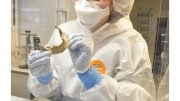
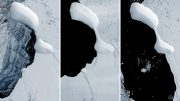
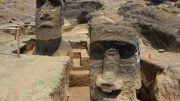
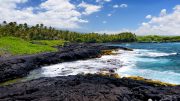
Be the first to comment on "Scientists Reveal the Genetic Timeline of Ancient Vanuatu People"